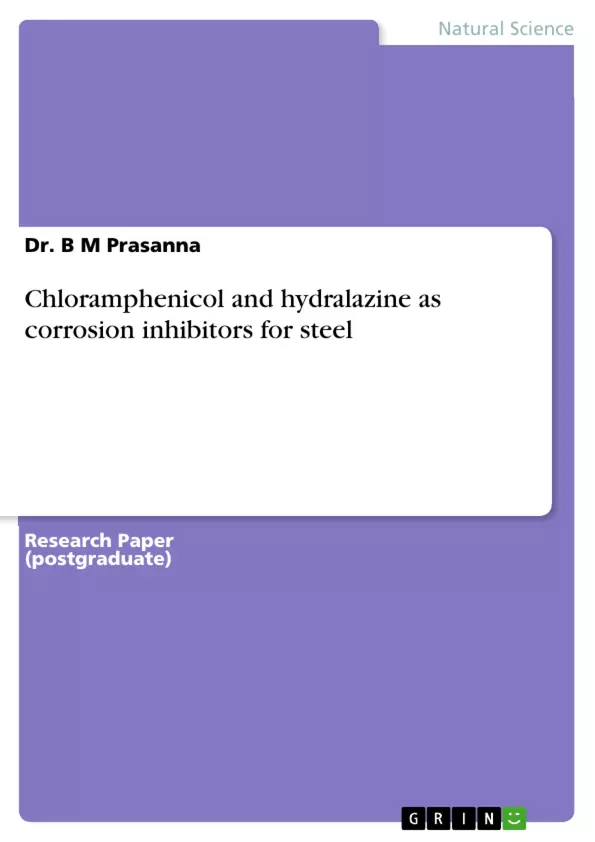The corrosion inhibition mechanism of Chlorophenicol and Hydralazine for the mild steel in 1M HCl was studied by chemical, electrochemical and adsorption measurement at 303-333 K temperature regions. The inhibition efficiency of the Chlorophenical and Hydralazine increases with increasing inhibitor but decreases with increase of temperature. The mechanism of the inhibition action attributed due to the adsorption of inhibitor on the surface of the metal, for which this adsorption process obeys Langmuir adsorption isotherm. The electrochemical Tafel analysis shows that the inhibitor acts as a mixed type, and gets adsorbed by either physically or chemically. Surface study was done by scanning electron microscopic method due to the formation of protective film on the metal surface.
Inhaltsverzeichnis (Table of Contents)
- CHAPTER-1
- INTRODUCTION
- Definition and importance of corrosion
- Economic effects
- Types of corrosion
- Dry corrosion
- Wet corrosion
- Uniform corrosion
- Galvanic corrosion
- Differential aeration corrosion
- Crevice corrosion
- Stress corrosion
- Intergranular corrosion
- Erosion corrosion
- Electrochemical theory
- Factors affecting the corrosion rate
- Nature of the metal
- Electrode potential of the metal
- Purity of the metal
- Hydrogen over voltage
- Relative areas of anode and cathode
- Nature of the corrosive product
- Environment surrounding the metal
- pH
- Temperature of the corrosive environment
- Humidity
- Corrosion rate measurements
- Weight loss measurements
- Electrochemical measurements
- Electrochemical Tafel polarization measurements
- Electrochemical impedance Spectroscopy (EIS)
- Adsorption isotherm
- Theoretical study
- Quantum chemical measurements
- Quantum chemical parameters
- Semi-empirical quantum measurements
- Methods of corrosion control
- Selection and Design of material
- Protective Coatings
- Metal coating
- In-organic coating
- Organic coating
- Cathodic protection
- Sacrificial anodic method
- Impressed current method
- Corrosion Inhibitors
- Types of corrosion inhibitors
- Adsorption corrosion inhibitors
- Passivation corrosion inhibitors
- Pickling corrosion inhibitors
- Vapor-phase corrosion inhibitors
- Slashing corrosion inhibitors
- Toxic effect of inhibitors
- Friendly corrosion inhibitors
- Effect of the molecule structure on corrosion inhibition
- Aim and scope of the present work
- CHAPTER- 2
- MATERIALS AND METHODS
- Materials
- Mild Steel
- Pre-treatment of electrodes
- Chemicals
- Electrolytic medium
- Inhibitor solution
- Acute toxicity studies
- Electrochemical cell and electrode assembly
- Pretreatment of the electrochemical cell
- Instrumental setup
- Corrosion Studies
- Chemical method
- Weight loss measurements
- Electrochemical measurements
- Electrochemical Tafel polarization method
- Electrochemical Impedance Spectroscopy (EIS)
- Adsorption Isotherm
- Activation Parameters
- Theoretical method
- Quantum chemical calculation
- Surface study
- Scanning electron microscopy (SEM)
- CHAPTER- 3 Chloramphenicol drug as a corrosion inhibitor for mild steel in 1M HCI solution
- Results and Discussions
- Weight loss measurements
- Electrochemical measurements
- Tafel polarization measurements
- Electrochemical impedance spectroscopy (EIS)
- Adsorption isotherm and thermodynamic parameters
- Activation parameters
Zielsetzung und Themenschwerpunkte (Objectives and Key Themes)
This book aims to investigate the effectiveness of chloramphenicol drug as a corrosion inhibitor for mild steel in a 1M HCl solution. The study delves into various aspects of corrosion, including its definition, types, and economic implications. It examines factors influencing corrosion rates, explores different methods of corrosion control, and investigates the effectiveness of chloramphenicol drug as a corrosion inhibitor.
- Corrosion inhibition
- Electrochemical measurements
- Adsorption isotherm and thermodynamic parameters
- Activation parameters
- Quantum chemical calculations
Zusammenfassung der Kapitel (Chapter Summaries)
Chapter 1 provides a comprehensive introduction to corrosion, covering its definition, importance, and economic effects. It outlines different types of corrosion, explains the electrochemical theory, and explores factors affecting corrosion rates. The chapter also discusses various methods of corrosion rate measurement and control.
Chapter 2 details the materials and methods employed in the study. This includes information on the mild steel used, the pre-treatment of electrodes, the chemicals used, the electrochemical cell and electrode assembly, the instrumental setup, and the various corrosion studies conducted.
Chapter 3 presents the results and discussion of the study, focusing on the effectiveness of chloramphenicol drug as a corrosion inhibitor for mild steel in a 1M HCl solution. The chapter analyzes the data obtained from weight loss measurements, electrochemical measurements (Tafel polarization and EIS), adsorption isotherm and thermodynamic parameters, and activation parameters.
Schlüsselwörter (Keywords)
Corrosion, corrosion inhibition, mild steel, chloramphenicol, HCl solution, electrochemical measurements, Tafel polarization, EIS, adsorption isotherm, thermodynamic parameters, activation parameters, quantum chemical calculations, surface study, SEM.
- Citar trabajo
- Dr. B M Prasanna (Autor), 2016, Chloramphenicol and hydralazine as corrosion inhibitors for steel, Múnich, GRIN Verlag, https://www.grin.com/document/377086



